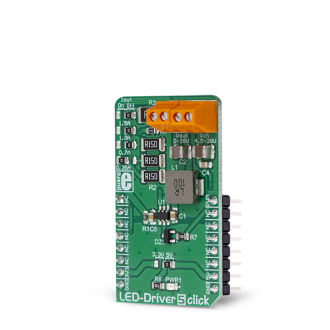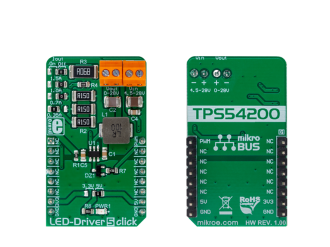
We strongly encourage users to use Package manager for sharing their code on Libstock website, because it boosts your efficiency and leaves the end user with no room for error. [more info]

Rating:
Author: MIKROE
Last Updated: 2018-12-24
Package Version: 1.0.0.0
mikroSDK Library: 1.0.0.0
Category: LED Drivers
Downloaded: 5106 times
Not followed.
License: MIT license
LED Driver 5 is a Click board capable of driving an array of high-power LEDs with constant current, up to 1.5A. This Click board features the TPS54200, a highly integrated LED driver IC with many useful features.
Do you want to subscribe in order to receive notifications regarding "LED Driver 5 click" changes.
Do you want to unsubscribe in order to stop receiving notifications regarding "LED Driver 5 click" changes.
Do you want to report abuse regarding "LED Driver 5 click".


Library Description
You can find all the functions for controlling LED lighting in the file Click_LED_Driver5_pwm
Key functions:
uint32_t leddriver5_pwmInit(uint16_t freq) - PWM init functionvoid leddriver5_pwmSetDuty(uint16_t duty) - PWM set duty functionvoid leddriver5_pwmStart() - PWM start functionvoid leddriver5_pwmStop() - PWM stop functionExamples description
The application is composed of the three sections :
void applicationTask()
{
_dutyCycle += 250;
leddriver5_pwmSetDuty(_dutyCycle);
if (_dutyCycle > 10000 )
{
_dutyCycle = 0;
leddriver5_pwmSetDuty(_dutyCycle);
Delay_ms(2000);
}
Delay_ms( 100 );
}
Other mikroE Libraries used in the example:
Additional notes and information
Depending on the development board you are using, you may need USB UART click, USB UART 2 click or RS232 click to connect to your PC, for development systems with no UART to USB interface available on the board. The terminal available in all MikroElektronika compilers, or any other terminal application of your choice, can be used to read the message.